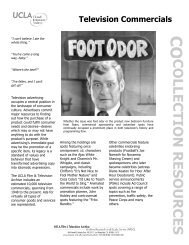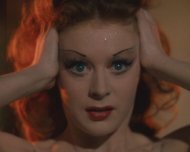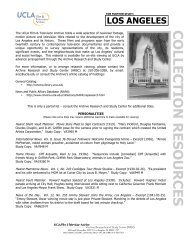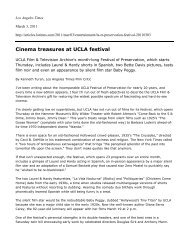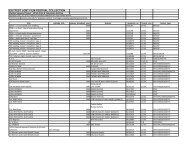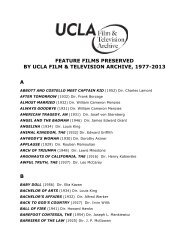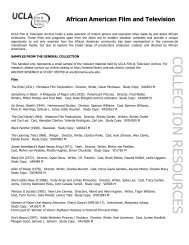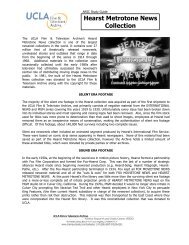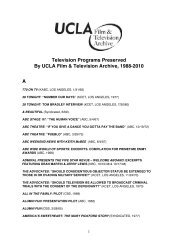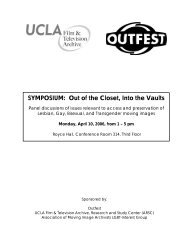"Heroic Grace" catalog - UCLA Film & Television Archive
"Heroic Grace" catalog - UCLA Film & Television Archive
"Heroic Grace" catalog - UCLA Film & Television Archive
Create successful ePaper yourself
Turn your PDF publications into a flip-book with our unique Google optimized e-Paper software.
films with King Hu) and Lau Kar-leung (working with Zhang Che before<br />
launching his own career as a director) developed long shots which cut<br />
smoothly together through exact control of what was pictorially salient<br />
at each moment: one or two bodies thrusting or flipping across the<br />
widescreen frame. The much-maligned zoom lens played a crucial role<br />
in this long-shot strategy, not only picking out the most salient action,<br />
but also lending its own rhythm to redouble that of the figures. The shot<br />
can start with a rapid zoom back, echoing the first whoosh of action, or<br />
the zoom can punch in and out, reinforcing the action’s rhythm.<br />
The opening test of strength between Hong (David Jiang Dawei/<br />
David Chiang) and Ma (Di Long/Ti Lung) in BLOOD BROTHERS can stand<br />
as a stripped-down model of the full-shot approach, which Zhang Che<br />
refined across a dozen years. The same principles rule LAST HURRAH FOR<br />
CHIVALRY (HAO XIA, 1979), the work of Zhang’s assistant and pupil John<br />
Woo. Look, for example, at the six-minute combat between Zhang (Wai<br />
Pak) and Pray (Fung Hak-on), in which 75 shots render each thrust and<br />
blow utterly intelligible, the whole sequence but a warm-up for the two<br />
grueling battles in the finale—which reveals the fearsome Pak as only a<br />
subsidiary villain after all. The Hong Kong martial arts style was far from<br />
uniform, however: against Zhang’s no-frills pan-and-zoom fights stands<br />
the pictorially dense, almost decorative imagery to be found in KILLER<br />
CLANS (LIUXING HUDIE JIAN, 1976) and other Chu Yuan (Chor Yuen) works.<br />
A younger generation of choreographers began to explore a more<br />
“precisionist” approach to staging and cutting combat. Here the action<br />
is built out of many more detail shots—a face, a body part, a weapon<br />
lashing out—and the rhythm comes not only from the figures’ action but<br />
also from a barrage of hyper-composed details, which we assemble into<br />
an integrated action. This became the dominant style of Woo’s 1980s<br />
Triad films, Tsui’s PEKING OPERA BLUES (DI MA DAN/DAO MA DAN, 1986),<br />
and Ching Siu-tung’s A CHINESE GHOST STORY (SIN LUI YAO WAN/QIANNÜ<br />
YOUHUN, 1987). The fights in the gangster’s lair at the close of Corey<br />
Yuen Kwai’s YES, MADAM! (WONG GA BAI CHE/HUANGJIA SHIJIE, 1985) perfectly<br />
illustrate this approach, with Michelle Yeoh’s dodges and feints captured<br />
in a flurry of tight, exactly-judged setups. And skillful choreographer-directors<br />
like Jackie Chan fused the two approaches; the climactic<br />
mall fight of POLICE STORY (GING CHAT GOO SI/JINGCHA GUSHI, 1985)<br />
superbly balances full-shot choreography with passages built out<br />
of precise details.<br />
Fig.1<br />
Fig.2<br />
One of the pioneers of rapid editing and rhythmic staging was King<br />
Hu, who perhaps best exemplifies the range of experimentation available<br />
in this kinetic genre. He was famous as a fast cutter (once boasting of<br />
making China’s first eight-frame cut), but just as important was his<br />
powerful awareness of screen space. Allowing his choreographer Han<br />
Yingjie to model his fights on Chinese opera rather than real kung fu, he<br />
experimented with unnerving, almost subliminal spatial effects. In the<br />
stupendously inventive DRAGON INN, as the woman Zhu (Polly Shangguan<br />
Lingfeng) fights with an adversary outside the inn, the camera tracks<br />
back to catch the crumbling edge of a wall; she may seem to be trapped<br />
(Fig. 1). A quarter of a second (that is, six frames) before the cut, a dim<br />
12<br />
shape pops up at the wall, and Chu starts to stab it (Fig. 2). Cut to a<br />
disorienting extreme long shot in which her attacker is already recoiling<br />
in agony (Fig. 3). The attack and the response are over before we have<br />
fully registered them. No less bold is the moment when the fleeing Mao<br />
(played by choreographer Han Yingjie) ducks behind a wall in long shot<br />
(Fig. 4) and appears at another end of it instantly, leaping up to the inn<br />
balcony (Fig. 5). Not only does the wall hide the mini-trampoline, but<br />
(allowing for the use of a double) it suggests that Mao commands an<br />
otherworldly speed. Hu’s films are full of such ingenious spatial twists,<br />
driving home the agility and resourcefulness of his fighters.<br />
For many young viewers today, the swordplay and kung fu films of<br />
Hong Kong’s Golden Age are less immediately accessible than the gunplay<br />
dramas and supernatural fantasies of the 1980s and ’90s. The suavity<br />
of Chow Yun-fat may seem more appealing than the self-torment of<br />
ONE-ARMED SWORDSMAN. And the 1960s and ’70s movies may seem<br />
embarrassingly rooted in crude conventions and local limits of budget,<br />
time, taste, and imagination. In fact, though, the crime and costume<br />
sagas owe everything to these strange and wondrous creations. Here we<br />
find stories which are refreshingly baggy, full of unexpected turns and<br />
returns. Here protagonists are defined through their obsessive pursuit<br />
of moral and professional achievement. And here we encounter a cinematic<br />
technique aiming to carry the characters’ percussive energy down<br />
into the fibers of our bodies. These films, cranked out by directors<br />
almost completely unaware of experimental cinema, made a revolution<br />
in the way movies work, and work upon us.<br />
copyright @ 2003, David Bordwell<br />
David Bordwell teaches at the University of Wisconsin—Madison,<br />
where he is Hilldale Professor of Humanities and Jacques Ledoux<br />
Professor of <strong>Film</strong> Studies. He has written several books on film theory<br />
and history, including two on Asian cinema: Ozu and the Poetics of<br />
Cinema (Princeton, 1988) and Planet Hong Kong: Popular Cinema and the<br />
Art of Entertainment (Harvard, 2000). He is completing a book on cinematic<br />
staging as practiced by Kenji Mizoguchi, Hou Hsiao-hsien, and<br />
other filmmakers.<br />
Fig.3<br />
Fig.4<br />
Fig.5



